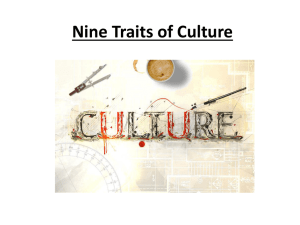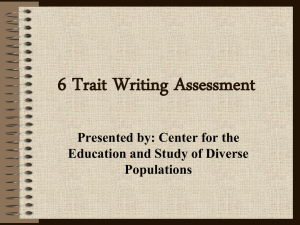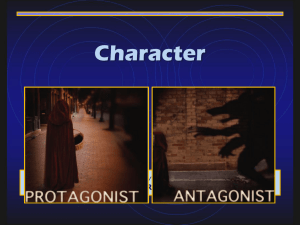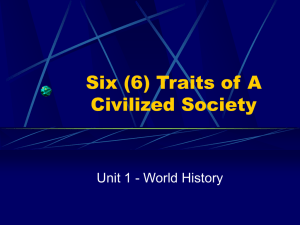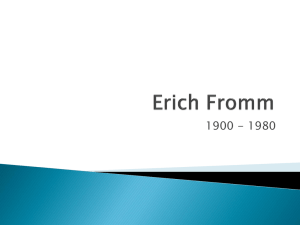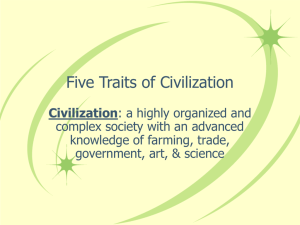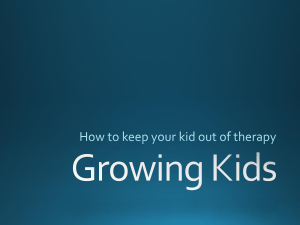6 Traits + 1 - San Marcos Writing Project
advertisement
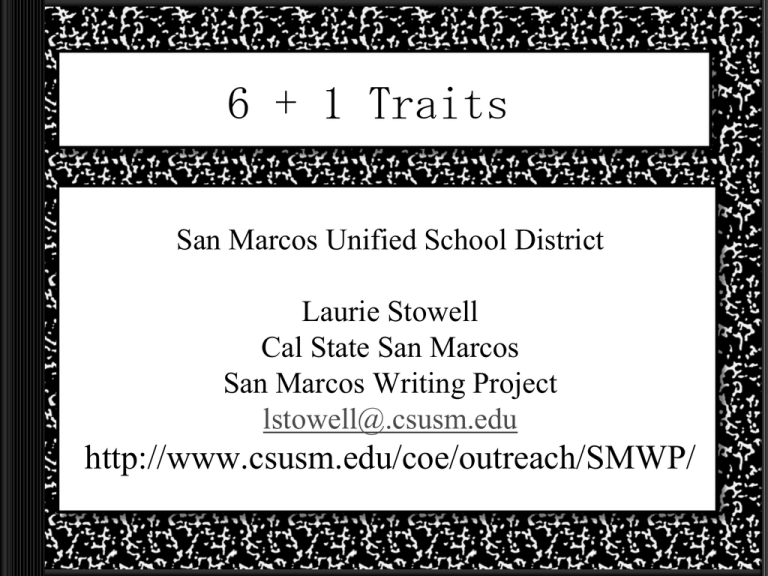
6 + 1 Traits San Marcos Unified School District Laurie Stowell Cal State San Marcos San Marcos Writing Project lstowell@.csusm.edu http://www.csusm.edu/coe/outreach/SMWP/ 6 + 1 Traits * Gives teachers, students and parents a common language to talk about writing Advantages of Analytic Scoring • Offers broad perspective • Challenges us to think of writing in new ways • Gives us a model for responding to students’ writing • Provides vocabulary for talking with students about writing • Provides a solid foundation for revision and editing • Allows students to become evaluators Assessment for writing Assessment of writing Brief history * K-16 teachers read and sorted stacks and stacks of papers * After sorting, they extrapolated what the specifics of the papers were that caused teachers to put them in different piles. * Lists were compiled, descriptors created, and common characteristics or TRAITS emerged. •“Assessment should be used as feedback only and not as reward or punishment.” -Jerome Bruner 6 + 1 traits are used: * In all 50 states, Great Britain, France, South America, China and the Middle East *By teachers primary through college *By teachers in language arts, math, science, social studies, foreign language and special education. The 6 traits + 1 * Ideas (details, development, focus) * Organization (internal structure) * Voice (tone, style, purpose and audience) * Sentence fluency (correctness, rhythm and cadence) * Word choice (precise language and phrasing) * Conventions (mechanical correctness) * And now they also look at Presentation (handwriting, formatting, layout) Writing is like a guitar Guitars generally have 6 strings. Each string has a different note or tone. Some are high and some are low. If you were to play a song with one string, the song would be rather dull, boring and monotonous. However if the six strings are played together and they are given an interesting rhythm, the gorgeous melody floats across the room and stirs the soul. Writing is the same in many ways. Without all the elements, the writing is lacking. With all the elements, the writing can stir the soul. Another way to look at the traits: Revision • Ideas • Organization • Voice • Word choice • Sentence Fluency (creating meaning) Editing Conventions Presentation (getting things right) The six traits are not a writing curriculum! They are a way to link effective classroom centered writing assessment with revision and editing processes. Performance Assessment “Teachers ask the wrong question first… “What do we do?” -- putting the focus immediately on designing tasks - when they need to ask “What do we want kids to know and be able to do? How well? What does quality look like?” [We] need to ask these questions very clearly first.” Mike Hibbard, Education Update, 38(4), p. 5, ASCD, June, 1996 “We must change from a model that picks winners to one that will create winners.” -Harold Hodgkinson Michigan: The state and its educational system Scoring the 6 traits way: The Redwoods And Fox Why a 5 point scale? • Origin of and research on the trait model is 5 points • Analytic, not holistic • Classroom assessment, not large scale • Are we ranking and sorting? (summative) Or leading students to revise and edit? (formative) Tips on Scoring: • Use the complete scoring guide – not a shortened version • Read the scoring guide at the “5” level as a definition of the trait • Read the paper • Ask yourself, “Generally stronger or weaker on this trait?” • Work from the “5” down, or the “1” up • Use the full range of scores – “5” is not perfect and “1” is not an “F” Score for: •Ideas •Organization •Voice Voice: The Core Standards never mention voice outright, But they do mention style (See writing standard 4). Style is an umbrella term that in trait language encompasses voice, word choice, and sentence fluency. They all work together. Notice that standard 4 also suggests that the style should be appropriate to “task, purpose, and audience.” This ability to adjust style to fit context–and to write in a way that reaches an audience–is definitely a component of voice. Score: •Word Choice • Sentence fluency •Conventions “The key to assessment is the word itself. It comes from the Latin verb assidire: to sit beside. We are not ranking here. We are sitting beside a piece of writing and observing its qualities. We are finding a common language to talk about those qualities.” -Barry Lane Study finds use of 6+1 traits produces higher scores • A scientific study conducted by REL Northwest in 74 Oregon elementary schools showed that the 6+1 Trait Writing model caused a statistically significant increase in student writing scores during the year in which it was studied. 6+1 Scoring with traits • • • • Start with what is working What traits does this child have in this piece? What traits need work in this piece? Know the student and what he or she is capable of and can handle in a conference • Choose one or two things to work on in a particular paper How to teach the traits • How students learn the traits: Introduce 1 trait at a time: ideas, organization, voice, word choice sentence fluency, conventions. • Help students keep the big picture in mind • 10 things to do your first week back • Getting started with the traits • Top 10 tips for teaching writing assessment • Use the website as a resource Traits can be used with information writing Frogs are amphibians. They spend most of their life in the water but sometimes they live on land. They don’t have tales, they are pretty smooth and have bulging eyes. Frogs have long back legs so they can jump. There are many kinds of frogs, but they all have the same basic body structure. The largest frog is from Africa… Tree frogs live on all continents accept Antartica… -7th grade A revised piece A sticky pink tongue darts out to grab a small unsuspecting bug and- ZAP! It slurps it down for a mid-morning snack. Such is a moment in the life of the frog, a common amphibian found in all shapes, sizes and colors and in many places around the world. In fact, about the only place you won’t find some kind of frog is in the coldest parts of the world like Antarctica. As a cold-blooded amphibian, the frog cannot adapt to the year round freezing temperature of the air and water. From the largest African Goliath frog measuring about one foot long to the smallest tree frog which is only 1/2 inch, the daily struggle for survival is great… Did you know that many common frogs… are in danger of becoming extinct? It may not see important to make sure that frogs have a safe and clean place to breed and grow, but people need frogs for many more things than you may think… Adapting the traits to fit you • Just because there are six traits in the model, this does not mean that you have to give every paper six scores every time. • For example: a particular writing assignment on how species adapt to environmental factors, you might want to emphasize clear ideas, good organization, appropriate scientific terms and perhaps, conventional correctness. Geometry Suppose you ask students to determine how many different ways rectangular shapes can be combined to create a design for a one story building. You want them to write an explanation of each step in their thinking. You might choose to primarily on ideas (clarity), organization (steps in order), word choice (correct mathematics terminology) and conventions (including mathematical symbols). Weighting If you do not feel comfortable letting go of any trait altogether, try what many teachers have done: Weight the traits according to emphasis. For example if students in a group design a newspaper that might have sold in London in the 1800s, what is important? Weight the traits Let’s say the assignment is worth 100 points: • Ideas 25 • Organization 10 • Voice 10 • Word choice 20 Sentence fluency 10 Conventions and presentation 25 Weight them however you want: just give students a clear picture of what is critical. Guiding Principles • When you write every day, you improve. • Paint-by-number isn’t art; writing to prompts with formulas isn’t real writing, either. • If you have some choice in the task, you work harder and enjoy it more. • No one fails at writing or teaching writing. • We’re all learning. The Power of Metaphor • Robert Marzano's research stresses the importance of making meaning through comparison and contrast thinking. • Create a metaphor for a good piece of writing using the traits as a guide. Human Body: Forest: The Important Book: • Using The Important book by Margaret Wise Brown create and important book about the traits including icons to remember them better. • “The important thing about ideas is they are they heart of the message…” Publishers materials: – Write Source – Carson Dellosa – Scholastic Research and resources: Creating Writers (5th edition) by Vicki Spandel 6+1 Traits of writing: The complete guide grades 3 and up by Ruth Culham (Scholastic) 6+1 traits of writing: The complete guide grades K-2 by Ruth Culham 6+1 traits of writing: The complete guide for middle grades by Ruth Culham • http://educationnorthwest.org/traits • http://writingfix.com/index.htm • http://corbettharrison.com/lessons.html • http://denaharrison.com/Traits.htm • M.S. Teacher: http://www.kimskorner4teachertalk.com/writing/men u.html Elementary Teacher: http://www.edina.k12.mn.us/concord/teacherlinks/six traits/sixtraits.html • H.S. Teachers: http://www.literatelearner.com/6traits/page_template Common Core & 6 traits: • Color coded: http://www.smekenseducation.com/seeing-thetraits-within-the-common-core-standards.html • samples of scored papers: http://educationnorthwest.org/traits/ccss/samplesof-student-writing http://educationnorthwest.org/traits/ccss • http://sixtraitgurus.wordpress.com/ • http://teacher.scholastic.com/products/commoncore-state-standards/english-language-artsalignments.htm


